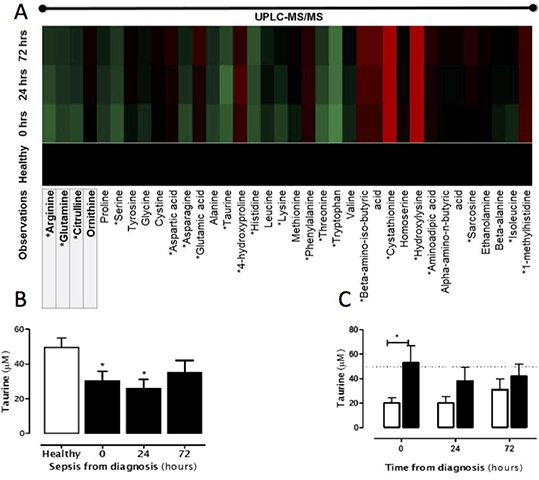Print version
Search Pub Med
| 226P London, UK Pharmacology 2016 |
Pilot study: Metabolic profiling of amino acids reveals a potential link between taurine and survival in sepsis
Introduction: Sepsis is defined by suspected infection with organ dysfunction (1). A diagnosis of sepsis is associated with profound metabolic shifts and a high risk of mortality. Of particular interest in sepsis are changes seen in amino acids and amines including those that influence directly or indirectly production of nitric oxide (NO). NO is formed from L-arginine, levels of which are influenced by other amino acids including glutamine, citrulline and ornithine. Here we analysed of a comprehensive array of 35 amino acids and amines in plasma from patients with sepsis in order to assess any associations with onset of disease and/or mortality.
Methods: Measurements in plasma from 37 patients with sepsis at diagnosis (0), 24 and 72 hours after diagnosis or from 21 healthy donors were performed. Samples were analysed as described previously (2). Samples were processed after protein precipitation using isopropanol containing 1% formic acid (v/v) and analysed by ultra-purification mass spectrometry (UPLC-MS/MS) with methanol containing 0.1% formic acid as mobile phase. Amine analysis was conducted by Xevo TQ-S tandem quadrupole mass spectrometer with concentrations reported by Acquity UPLC binary solvent manager, sampler manager and column manager.
Results: Of the analytes measured 21, including amino acids arginine, glutamine and citrulline, showed changes in plasma from patients with sepsis (Figure 1A). Individual analysis showed that, of these, taurine levels were decreased at early time points (Figure 1B) and lower in plasma of patients with sepsis that survived hospital stay (Figure 1C).

Figure 1. Amine array (A) and taurine (B) analysis of plasma from healthy volunteers and patients diagnosed with sepsis; (C) levels of taurine in plasma from survivors (white columns) or non-survivors (black columns) diagonised with sepsis mean ± SEM for n=37 sepsis and n=21 healthy and analysed by one-way ANOVA with Dunnett’s post hoc test (A/B) and two-way ANOVA with Bonferroni post hoc test (C).
Conclusions: Further replication and validation needs to be completed before a full appreciation of this data can be made, however, this pilot study confirms that sepsis is associated with profound changes in the metabolic profile of amino acids, including those associated with the NO pathway and additionally suggests that taurine may be a potential indicator of survival.
References:
(1) Singer M,et al. JAMA 315:801-810 (2016).
(2) Trautwein, Elke A et al.Am J Clin Nutr 52: 758-764 (1990).

